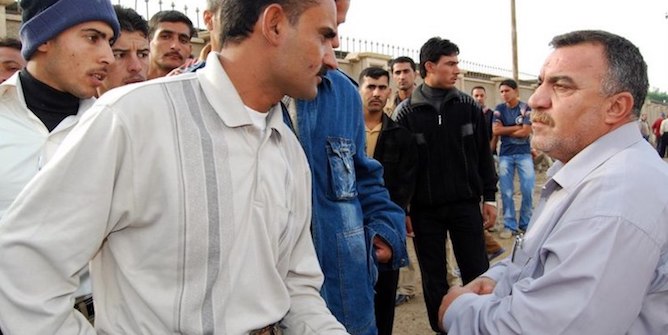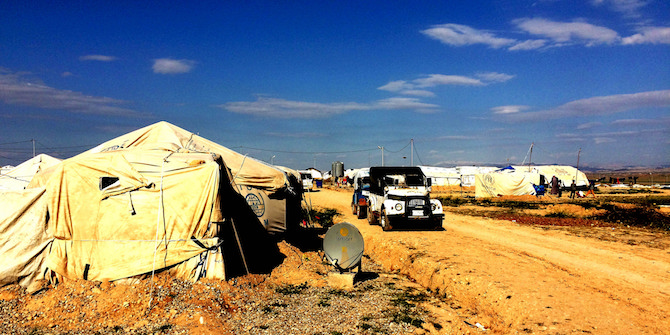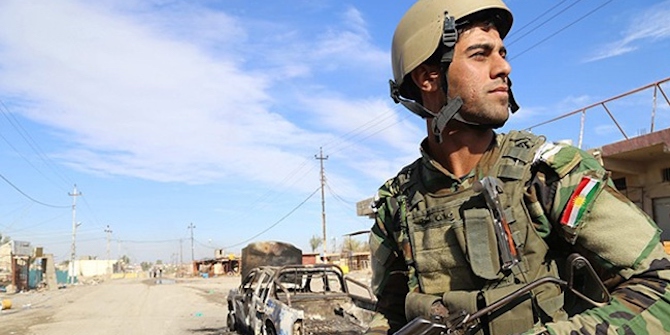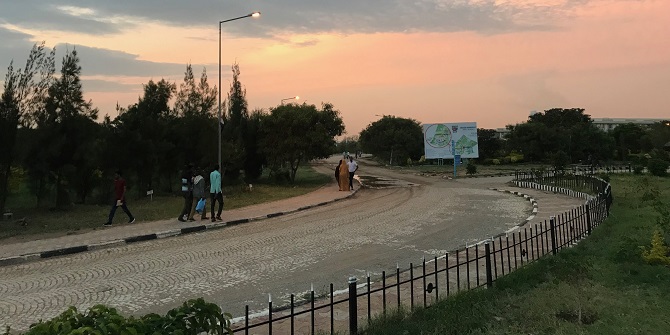by Zmkan Ali Saleem, Mac Skelton and Christine M. van den Toorn
This blog was originally published in the LSE Middle East Centre blogs. You can find out more about the Conflict Research Programme’s work in Iraq and the wider Middle East, here.

In October 2017, the Kurdish Regional Government’s (KRG) political and military hold over large swaths of the disputed territories evaporated overnight. A mix of military forces and militias backed by the Government of Iraq (GOI) overwhelmed Kurdish Peshmerga forces, quickly taking over strategic areas of Diyala, Salahadin, Ninawa, and Kirkuk. While legally and constitutionally these territories remain disputed, in actuality the KRG’s political and military influence has declined dramatically in a short period of time, leaving the GOI and its affiliates in control. What are the implications of renewed GOI control? What does this shift in the security arrangement tell us about future KRG–GOI attempts to resolve the dispute over these territories?
Preliminary interviews highlight the fact that the nature and form of GOI control varies considerably across the disputed territories. The campaign against ISIS has left the federal government with a fragmented military and administrative apparatus. While legally speaking the state-backed Popular Mobilisation Forces (PMFs) have been incorporated into the federal government since 2016, in reality the different factions vary greatly in their command structures, priorities, and loyalty to the GOI. Thus, instead of solely a KRG–GOI conflict, the disputed territories face a varied field of political and military actors vying for control. This fragmentation of public authority impacts not only the security of the disputed territories but also the provision of services and administration. In what follows we provide an overview of these dynamics in one of the most complex of the disputed areas, northern Diyala. Future outputs will examine similar features in Tuz Khormatu, Kirkuk and multiple towns in Ninewa.
Khanaqin District Centre
The Diyala district of Khanaqin, including subdistricts of Jalawla and Saadiya, is an ethnically diverse area inhabited by Arabs, Turkmen and a large Kurdish population. The KRG has exerted major influence over the area since 2003 administratively and militarily, particularly in the city centre of Khanaqin, where pro-KRG Shia Kurds constitute the largest portion of the city’s inhabitants. During much of the post-2003 era, both the Iraqi government and KRG were funding separate administrative entities. The KRG directorates of municipality, construction and development, and education overlapped with federal counterpart administrative entities.
Neither the KRG nor the federal administrations were apolitical. Since 2003, both key KRG and GOI functionaries have been staffed by Kurdish actors loyal to political parties, especially the PUK. The GOI reassertion has not fundamentally altered this arrangement, in part due to the PUK’s longstanding ties to Iran as well as Iranian-back actors in Iraq (such as the Badr Organisation, the largest and most powerful Iranian-backed element of the Shia PMFs in Diyala, led by Hadi al-Ameri) which operate in the area. With the events of October 2017 and the assertion of GOI control over the local security apparatus, federal and Badr authorities did not force out all of the existing Kurdish, predominately PUK administration. They permitted the co-presence of KRG and GOI administrations for the provision of public services.
The current distribution of administrative power is by no means equal between the GOI and KRG, however. The centre of political control has shifted towards the federal ministries and the governorate capital of Ba’quba. The mayor’s office and directors now execute their duties with the knowledge that the governorate authorities control the bulk of Khanaqin’s salary distributions. Moreover, federal influence over Khanaqin’s security apparatus allow Ba’quba to hold sway over the administrative reach of certain KRG entities. A senior KRG judge described the marginalisation of the Kurdish courts: “The Diyala governorate took measure to force the KRG courts out of Khanaqin by demanding that the city’s federal police chief not send any claims to Kurdish judges.” At present, federal courts run by Arab judges control the judiciary, and the KRG courts have relocated to PUK-controlled territory.
Though the centre of power has shifted to the provincial government in Ba’quba, federal functionaries in Khanaqin have little operating support from the office of the governor and his directors. City and town council members indicated that they possess neither the budget nor the authority to propose or oversee development projects. Reconstruction funds remain meagre from both the regional and federal governments, and they have largely come from private individuals and international NGOs.

This lack of funds for public works has generated frustration among locals in light of the fact that Khanaqin is rich in oil and cross border trade revenues. The revenues of the Paruezkhan border crossing have long been under KRG control, and this has not changed following the events of October 2017. Control over the high traffic Al-Mounzariah border crossing is now in the hands of federal authorities, however, tipping the balance in revenue generation towards the GOI. As a general point, Khanaqin’s Kurds have alleged that the GOI has strategically placed loyal Iraqi Arab functionaries in revenue producing institutions such as Naftkhana oil fields and the Al-Mounzariah border crossings to ensure control over the city’s wealth.
Security is shared but is heavily dominated by the federal authorities. Since October 2017, the Federal Army and Badr Organisation forces have allowed Kurdish intelligence & security forces (Asayish) to stand at checkpoints, though they have been stripped of the authority to make arrests. The arrangement, which Badr and the PUK struck under Iranian influence, aimed to appease a large pro-KRG Shia Kurdish population concentrated in the centre of Khanaqin district. (While the Shia Kurds of Khanaqin share a religious sect with the ruling parties in Baghdad, they are not politically aligned with them.) This population has felt increasingly vulnerable between 2014 and the present, in large part due to the significant presence of Sunni Arab IDPs in the district who fled the northern, central, and southern Sunni-populated parts of Diyala to the relative safety of Khanaqin after the rise of ISIS.
Locals see the problem with the diminished Kurdish security presence as a matter of capacity. The GOI and Badr have not adequately distributed their own forces to the area, leaving the local Kurds and police alike fearful of attacks from insurgent groups still active in Khanaqin’s nearby areas. A high-ranking official in the Khanaqin police force stated: ‘Now that the Peshmerga and Kurdish security forces are no longer here to provide security and protection, the doors of the district are wide open for radicals and terrorists to come in and carry out attacks and terrorise the population.’
Allowing the Kurdish security apparatus to have more equal footing with Badr and GOI troops through continued PUK–Badr and KRG–GOI talks might help reduce the risk of such threats, or at very least assuage local fears of violence. This perception is not limited to the Kurdish inhabitants of Khanaqin. Interviews conducted in September 2018 with Arab, Turkmen, and Kurdish members of the city’s council confirmed a consensus that security has become more fragile in the post-referendum era.
Jalawla
Jalawla, a town west of Khanaqin, has historically held a large Kurdish population. This number dwindled during the violence and instability of the post-2003 era, as extremist groups targeted Kurdish and Turkmen ethnicities. Many Kurds fled for safer places like Khanaqin, and the trend only intensified with the rise of ISIS and the subsequent struggle to retake the city. Up until 2014, the demographic makeup of the town was 60% Arab, 35% Kurd, and 5% Turkmen. With the displacements after the rise of ISIS and later the referendum, currently the distribution is roughly 85% Arab, 10% Kurd, and 5% Turkmen. Of the Kurds who fled Jalawla following the events of October 2017, many of those who have yet to return are affiliates of the Kurdish security apparatus.
During the first decade of the post-2003 period, Kurdish security forces were not in control of Jalawla though there were PUK security forces in the subdistrict to project the party’s headquarters. The Iraqi Army and federal police served as the main forces on the ground. When the federal army withdrew from Jalawla in the face of ISIS in 2014, the Peshmerga and Badr clashed with ISIS forces starting in June 2014 and continuing for four months. Finally, in a joint operation, the joint security force overtook Jalawla in November 2014. A deal between the PUK and Badr stipulated that Kurdish forces were to be granted control over Jalawla while Badr would have jurisdiction over nearby Saadiya whenever the towns were liberated.
As the Peshmerga solidified a presence in the town between late 2014 until October 2017, they levelled accusations against segments of Jalawla’s Sunni Arab population of having sided with ISIS. These accusations were mostly directed towards members of the local Karawi tribe, who have been opposed to a Kurdish presence in the town for decades. Both Karawi and non-Karawi Sunni Arab returnees claim that they were not allowed access to their homes on account of this blanket accusation, according to Sunni Arab members of the AAH. A significant portion of the population did return, however, and local actors such as the director, Shaykh Yacoub al Lheibi, and several major INGOs contributed to reconstruction efforts during this period.

The 2017 referendum resulted in the expulsion of the Peshmerga and the arrival of government-backed Badr and Asaib Ahl Al Haq (AAH) to Jalawla. The AAH, a pro-Iran militia accused of committing anti-Sunni atrocities in other parts of Iraq, took advantage of the Karawis’ growing animosity towards the Kurds in order to bring a portion of the Sunni Arab locals into its ranks. Sunni Arab AAH now patrol the area. A Sunni Arab member of the AAH explained his decision: ‘Look, the Kurdish forces harmed Jalawla and its Arab residents. They applied strict security measures and were making it very difficult for the Arab IDPs to return to the town.’
Our field visits to Jalawla suggest that the Sunni Arab participation in the AAH has by no means put them on equal footing with the Shia Arab leadership. One of our field researchers personally witnessed a heated interaction where a Shia AAH commander aggressively insulted a group of local Sunni Arab AAH members, prompting one of the Sunni Arab recruits to plead, ‘You can’t just treat us as if we’re nothing.’
According to a Jalawla government official, the awkward alliance between Sunni Arabs and AAH has led to the marginalisation and endangerment of the Kurdish population. He said, ‘I don’t go outside of my house much, for fear of my life.’ The Federal army and police have little authority amidst this AAH and Badr-dominated security landscape in Jalawla.
On the administrative side, neither the governor of Diyala, nor the officials in Baghdad, have challenged the emerging power players in Jalawla. Some local administrative officials claim that this is because the governor and some on the provincial council are beholden to Iranian interests in the province. They simply cannot challenge the presence of groups like AAH. This fragmentation and layering of public authority has resulted in a lack of services and public works, paralysing government institutions. One official stated that money from the local government in Diyala was dedicated for three projects in Jalawla including the Salam Water project, a sport club and a dual carriageway. He noted, ‘The three projects remained on paper only and politicians in the local government in Ba’quba stole the funds for these projects.’ Jalawla claims to have not received funds from the government for the reconstruction efforts, but some money has been raised from donors and from INGOs, particularly Oxfam.
The crisis in public authority in Jalawla is unlikely to change without decisive GOI intervention if only because of the sheer amount of money at stake in maintaining the status quo. PMUs, and particularly the AAH, generate enormous cash flows in Jalawla. For instance, the AAH collects money through illegal taxing of trucks carrying trading goods from the KRI to the rest of Iraq. The AAH man checkpoints on commercially strategic roads and impose taxes on vehicles passing through, earning an estimated amount of $300,000 daily through checkpoint fees across Jalawla, according to a government official. This has helped the AAH to widen its networks of patronage in the area. The Shia militia party has used illegal taxation to pay the salaries of its fighters and followers, thus shifting the political marketplace in its favour.
Conclusion
The above case study of northern Diyala has revealed some of the emerging dynamics of governance and security in the disputed territories since the October 2017 GOI takeover. The nature and form of this reassertion of federal control is distinct in each locality. As the data indicates, the layering and fragmentation of public authority presents enormous obstacles to the effective provision of services and security. Forthcoming interviews and data collection will reveal a detailed picture of these evolving political and security realities across a broader geographic scope, including the disputed areas of Salahadin, the Ninewa Plains and Kirkuk. Findings will be published in a December 2018 report, which will include recommendations for policy-makers.
Note: All unattributed quotes are from interviews conducted by the authors in August–October 2018. Those interviewed included officials in Khanaqin, Sunni Arab members of the AAH in Jalawla, and government officials in Jalawla.
*This blogpost is part of the LSE research project Public Authority and Iraq’s Disputed Territories led by Christine van den Toorn, examining the territorial dispute between the Government of Iraq and the Kurdistan Regional Government. This project forms part of the Conflict Research Programme, funded by the UK Department for International Development to provide research and policy advice on how the risk and impact of violent conflict might be more effectively reduced through development and governance interventions.
The CRP blogs gives the views of the author, not the position of the Conflict Research Programme, the London School of Economics and Political Science, or the UK Government.





